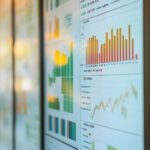Zennemis – How can we make airport security better while making travel smoother? The answer is in using tsa data science and analytics at the Transportation Security Administration. By using advanced predictive models and analytics, we’re not just better at spotting threats. We’re also making airports run more smoothly.
The Transportation Security Administration focuses on safety and efficiency. They’ve come up with new tech like the Reduced Form Factor-Computed Tomography (RFF-CT) system. This system is perfect for smaller airports where old security methods don’t work well.
These new technologies, from the Screening at Speed Program to changing how we use data, are changing how we see airport safety and efficiency. Join us as we look into the future of making airports safer and more efficient.
The Role of Data Science in Transportation Security Administration
Data science is key for the Transportation Security Administration (TSA). It helps in spotting threats early and makes operations more efficient. By using predictive modeling for TSA, we can predict security risks before they happen. This changes how we keep passengers safe and manage airport operations.
Enhancing Threat Detection through Predictive Analytics
We use advanced data analysis to look at passenger data and travel habits. This helps us find people who might be a security risk early on. Our analytics tools for TSA operations help catch fake identity documents and stop threats before they start.
Improving Efficiency and Speed at Security Checkpoints
Data analysis helps us make screening faster and more efficient. We use past data to guess how many people will come and when. This lets us plan better and use our resources well during busy times.
This makes going through security faster and smoother. Passengers get a better experience, and we keep security high.
Case Studies of Successful Implementations
Some examples show how data-driven strategies work well. For instance, better baggage screening has improved our operations a lot. These examples show how using predictive modeling for TSA and analytics tools helps make decisions. This leads to better security and saves money.
TSA Data Science and Analytics
The Transportation Security Administration (TSA) uses advanced methods to make airport security better. We use machine learning to look into big datasets and find threats early. This helps us improve our security steps.
How TSA Utilizes Machine Learning
Machine learning helps us spot patterns and trends that might show up as threats. This tech lets us make smart choices based on data. It helps us stop threats fast. By automating some tasks, we make our security faster and safer for everyone.
Data Mining Techniques for Enhanced Security
Data mining is key in spotting odd passenger behavior and luggage patterns. We use complex algorithms to go through lots of data. This shows us things that normal checks might miss. It makes our safety checks better at airports.
Real-time Data Analysis Tools Implemented by TSA
Our real-time data tools give our team quick info. They help us act fast on new threats and keep our security up to date. With these tools, we work more efficiently and keep air travel safe.
Integrating New Technologies for Better Security
Innovation is key to improving the Transportation Security Administration’s work. By using the latest technology, we aim for better efficiency and effectiveness. We focus on bringing in new tech to stay ready for new security challenges.
The Open Threat Assessment Platform Development
The Open Threat Assessment Platform shows our commitment to a flexible way of analyzing threats. This platform lets us quickly change our plans when new threats appear. By using tsa data visualization techniques, we can spot patterns and trends better. This helps us stop threats before they happen, making flying safer for everyone.
Innovations Like RFF-CT for Smaller Airports
The Reduced Form Factor-Computed Tomography (RFF-CT) system is our answer for smaller airports’ security needs. It makes baggage screening effective without losing detection quality. With tsa data visualization techniques, we can quickly analyze complex data. This lets security teams focus on important tasks while keeping safety high. Our work aims for a smooth travel experience, keeping all passengers safe.
Collaborative Efforts in Tactical Data Analysis
In today’s complex threat landscape, working together is crucial for TSA’s success in tactical data analysis. By forming partnerships, we keep our data science strong and ready for new threats. This teamwork boosts our efficiency and makes us safer.
Public-Private Partnerships Enhancing TSA Capabilities
Public-private partnerships are vital for TSA’s data science and analytics. By teaming up with private companies, we get access to new tech and know-how. This has led to over 1,400 intelligence products and expanded our Field Intelligence Officer program to more airports.
This teamwork lets us share important info with local and state authorities. It helps us stay one step ahead of threats.
Engagement with Industry Partners for Technological Advancement
Working with industry partners is key to TSA’s innovation in data science and analytics. Projects like the Air Domain Intelligence and Analysis Center show our drive to improve aviation security. We share information widely, making the transportation sector safer.
By using our partners’ strengths, we create better analytical models. These models help us spot and stop risks more effectively.
Conclusion: TSA Data Science and Analytics
We are changing how we ensure transportation security with TSA data science and analytics. By using advanced technologies, we can look at different kinds of data. This includes CCTV footage, passenger lists, and social media. These help us improve our security at airports.
Through this analysis, we can spot threats automatically, making our work more efficient. We use machine learning to predict security risks by looking at past data and how passengers act now. This makes our security stronger and helps us plan better for crowds.
It’s important to balance security with privacy, but we’re getting better at handling data. This makes traveling smoother for everyone.
The future of TSA data science and analytics is exciting. We plan to use more real-time data, social media, and biometrics to fight new security threats. Our commitment to new tools is key to making air travel safe and efficient in the U.S. We aim to keep providing secure air travel for everyone.
FAQ: TSA Data Science and Analytics
How does TSA utilize data science and analytics for security?
TSA uses data science and analytics to boost threat detection and make operations more efficient. We apply predictive modeling and advanced analytics to spot security risks. This helps us improve how we process travelers at checkpoints.
What is predictive modeling in the context of TSA operations?
Predictive modeling uses past data to predict future threats and risks. This helps us act early to keep travelers safe.
How does machine learning contribute to airport security?
Machine learning looks through huge datasets to find patterns that show security threats. This lets us take steps before threats happen, making airports safer.
What types of data visualization techniques does TSA implement?
We use different data visualization methods to keep an eye on security data. This helps us respond fast to new threats and improve our strategies.
Can you provide examples of successful case studies in TSA data analysis?
Yes, for example, our advanced baggage screening has shown how data-driven decisions can make a big difference. It has improved our operations and the experience for passengers.
What role do public-private partnerships play in TSA’s data capabilities?
Public-private partnerships help us get better at data analysis. They bring in outside expertise and speed up the use of new technologies in our security work.
How does the Open Threat Assessment Platform enhance TSA operations?
The Open Threat Assessment Platform lets us analyze threats in a modular way. This means we can quickly adapt to new threats, making our security better.
Why is innovation in security technology important for TSA?
Innovation keeps TSA ahead in transportation security. It helps us adapt to new threats while keeping the highest safety standards for travelers.




